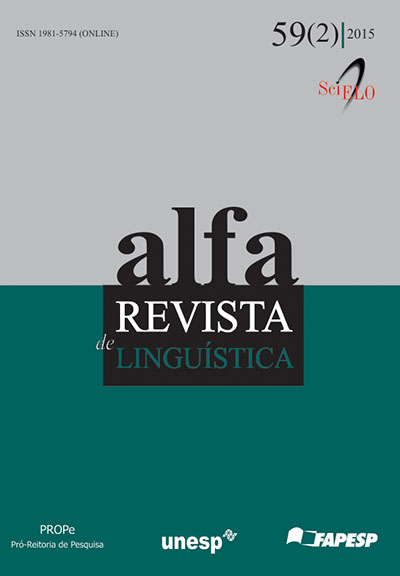Prosody in Brazilian Portuguese syntactically ambiguous sentences: duration cues
DOI:
https://doi.org/10.1590/1981-5794-1504-7Keywords:
Prosodic boundaries, Phonological phrase, Attribute, Local and non-local reading, Lengthening,Abstract
Taking into account syntactically ambiguous sentences related to local or to non-local readings, this paper analyses the duration effects spans as clues to prosodic mapping in Brazilian Portuguese sentences. The discussion is about whether BP speakers differentiate the readings by making a syllable longer, according to the prosodic domain of the intended meaning. This way, this paper shows a comparative study on the production of 30 BP speakers of 9 NP1-V-NP2-Attribute sentences, whereas one interpretation guides to a phonological phrase boundary between NP2 and the Attribute, while the other interpretation does not. The prosodic theory of Nespor and Vogel (1986) was chosen to discuss about the topic. . The results have not shown a relevant statistical difference in lengthening when considering only the readings, although they have indicated a strong correlation between the interpretation and the speaker; also, in all meaningful cases there were longer durations when the attribute was related to NP1, that is, where there is a phonological phrase boundary inserted between NP2 and the Attribute.Downloads
Download data is not yet available.
Downloads
Published
28/04/2015
How to Cite
ANGELO, M. C.; SANTOS, R. S. Prosody in Brazilian Portuguese syntactically ambiguous sentences: duration cues. ALFA: Revista de Linguística, São Paulo, v. 59, n. 2, 2015. DOI: 10.1590/1981-5794-1504-7. Disponível em: https://periodicos.fclar.unesp.br/alfa/article/view/6527. Acesso em: 31 dec. 2025.
Issue
Section
Papers
License
Manuscripts accepted for publication and published are property of Alfa: Revista de Linguística. It is forbidden the full or partial submission of the manuscript to any other journal. Authors are solely responsible for the article's content. Translation into another language without written permission from the Editor advised by the Editorial Board is prohibited.

